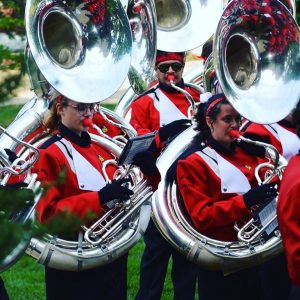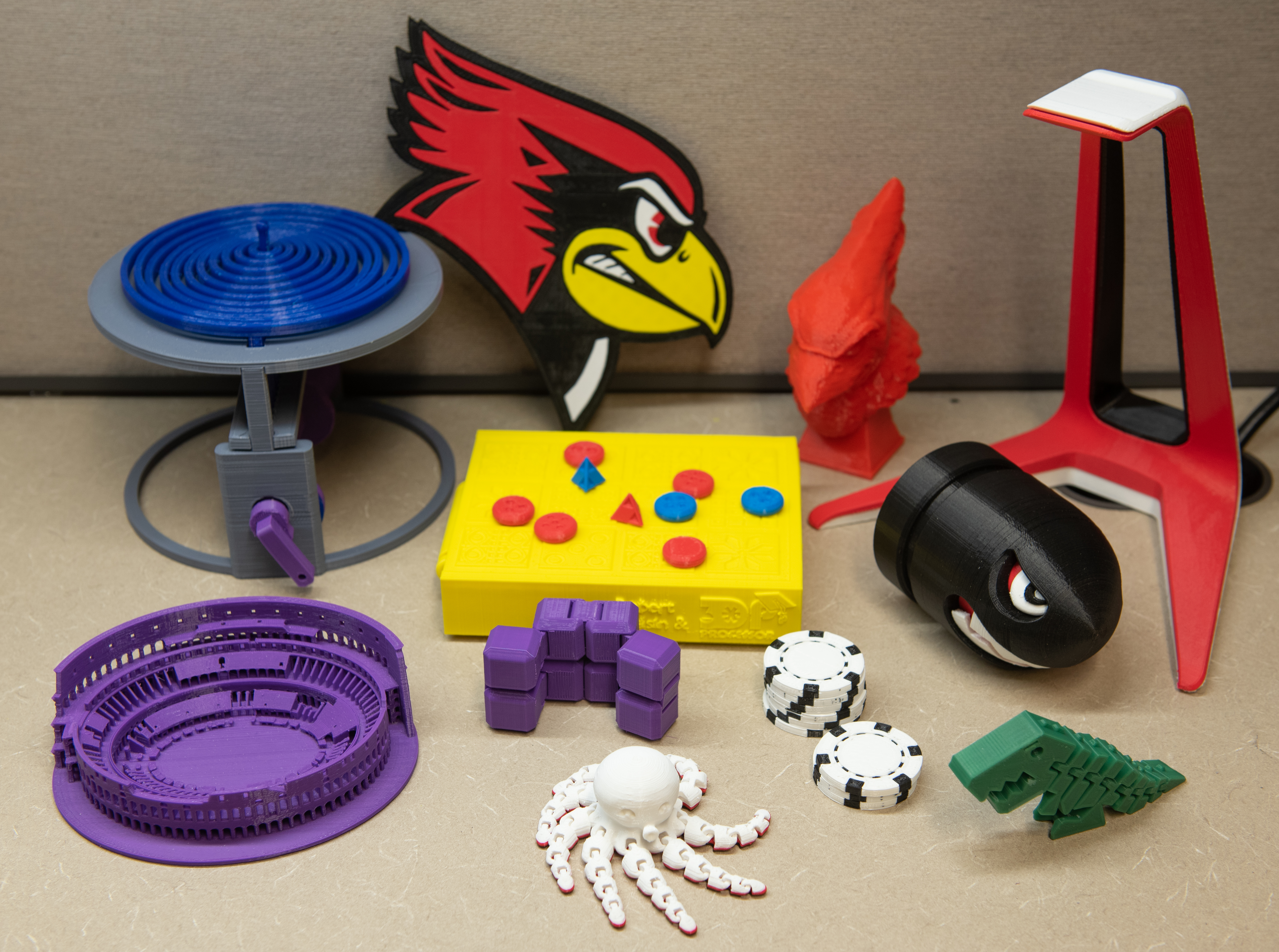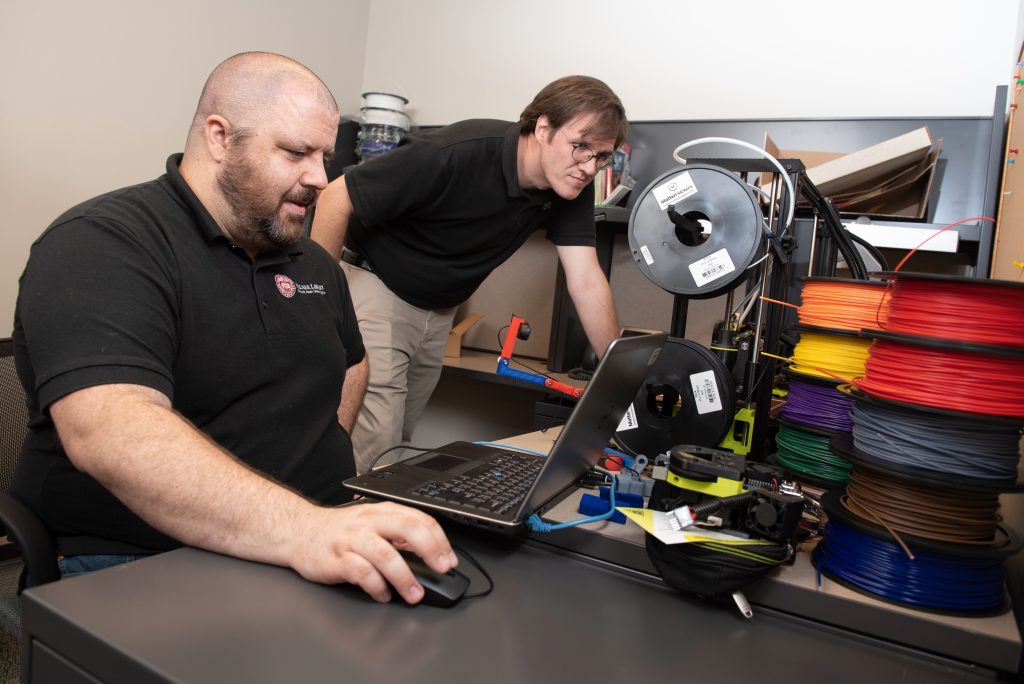When freshman Redbird Kaitlin Dobbeck visited Milner Library for the first time, she saw something that sparked her creativity.
“I went to the third floor and immediately was attracted to the 3D printer,” Dobbeck said. “I’ve only ever seen them in videos or talked about in articles, so I thought it was super exciting that there was one right there in the open.”
Dobbeck plays tuba in the Big Red Marching Machine. She saw a sign on the printer indicating it was free for Illinois State students, faculty, and staff to use, and wondered if there was anything she could make for her tuba. The 3D printer display gives a link to the website Thingiverse, which has 3D files available for public use.

Kaitlin Dobbeck (right) discovered 3D printing at Milner, leading to the tuba section of the Big Red Marching Machine to create their own custom red mouthpieces.
“One of the options was a tuba mouthpiece,” she said. “I thought that it was too good to be true but decided to give it a go anyway. I filled out the form and submitted my first request.”
Dobbeck started using the mouthpiece during rehearsals and found it worked great. Mouthpieces can cost up to $100, and through the printer, Dobbeck has discovered a free, customizable option. She told her fellow tuba players, and they started printing their own. Stories like Dobbeck’s are why Milner Library decided to get a second 3D printer for the 2019–2020 school year.
3D printing launched as part of the Milner Library Make It Space that opened last fall. Initial interest was strong, but Milner staff were flooded with requests after moving the first printer to its current home on the third floor from a publicly inaccessible office on the first floor. Requests rose from 83 requests in fall 2018 to 209 requests the following spring, a 251 percent increase.
“Having it out in the open for people to see is the best way to market it,” said Paul Unsbee, director of Library Information Technology Services. 3D printing is the process of taking a digital 3D model and, using specialized software, sending it to a 3D printer which then prints the model layer by layer. Different 3D printers use different materials, but Milner’s uses polylactic acid (PLA) plastic.
Steve Koehler, digital media specialist at Milner Library, handles the bulk of the print jobs. Koehler graduated with an arts technology degree and loves to build and design objects.
“I told Paul at the beginning, ‘I want to do this. I need to be involved with this,’” Koehler said.
Koehler receives about three to four new requests every day and finishes the same number of objects. Some basic rules are in place to make the process as efficient as possible. Projects requiring multiple pieces are submitted as separate jobs to keep individuals from taking over the queue. Additionally, requests for objects used for class projects or research are moved to the front of the line. Most requests have a finished object within a week of being submitted.
“My job has really evolved to where most of what I am doing is 3D printing,” Koehler said.
Milner places few restrictions on what can be printed, other than that objects that can be used as a weapon or enhance a weapon are not allowed to be printed. There are also restrictions on size, and Milner offers to scale down objects to meet those requirements. Otherwise, users are free to print whatever they can imagine.
Unsbee said many early requests were from people wanting Reggie Redbird logos and representations of characters from popular culture.
“People ask me, ‘Do you really want students printing off little figurines?’ I say, ‘Of course I do.’ Being able to have an object made of something they enjoy and that they can hold in their hands makes the technology more real for them,” Unsbee said. “And they will think of using the service later if they have classwork where the tech would be helpful.”
Some of Milner staff’s favorite projects are those, like Dobbeck’s mouthpiece, in which users are making objects to solve problems. Last fall, Katrina Miley ’19 recreated a 4,500-year-old board game called The Royal Game of Ur. She used the printed version of the game during her student-teaching to help students learn more about ancient Sumerian history. Wolfgang Stein, a professor of neurophysiology in the School of Biological Sciences, created an adapter for his smartphone allowing him to use lenses from microscopes and photograph specimens on the fly.
Koehler expects interest to pick up even more with the addition of the second printer and as stories of successful projects are shared.
“I love doing this is because I do love helping the students,” Koehler said. “Even if it’s not directly related to their education, I love to help them any way I can, and this is a very tangible way I can do it.”
If you are a current student, staff, or faculty wanting to create your own 3D printed object, fill out the form on the Milner Library website. See if you can spot the Big Red Marching Machine’s tuba players sporting their custom red mouthpieces during football games this fall!


